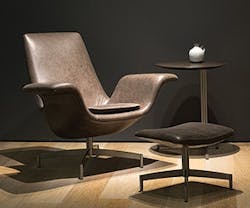While many people in the A&D world spend the days leading up to NeoCon putting the finishing touches on their booths or breaking in shoes and restocking card cases with one hand clutched around a glass of rosé, during the weekend before the 2016 trade show, Dan Chong was entering HBF as its new president. However, while he is reveling in the new position and the changes being made under his watch, he is in no way a newcomer in the industry.
Growing up as the child of an architect, Chong said his father had a profound influence on his career. With an industrial design fine arts degree under his belt, he went on to receive his MBA from the University of Michigan. From there, Steelcase’s management training program was the perfect fit.
“When I interviewed with Steelcase and Herman Miller, [my father] knew the companies very well, and thought highly of both,” Chong explained. “So it was my father’s influence that helped me become interested in the industry.”
Gaining his foothold through an industry giant such as Steelcase, he most recently went to work for Allermuir, bringing a broader recognition to the brand. His move to HBF last summer signaled the company’s growing focus on enlivening the 37-year-old company from the inside out.
“HBF is a very well-known brand, and, beyond that, a very respected brand,” Chong said. “And even beyond that, a high percentage of the people that I’ve spoken to have a fondness for the brand. As for the products, they’re increasingly less relevant in terms of the types of products that designers and clients are looking for. We’re rebranding the company in virtually every aspect of the organization, and the external evidence will be in the branding and the way we communicate to our customers.
“But the back end of that, which makes it very real, is an almost total transformation of the organization,” he continued. “It’s a very authentic transition.”
While the joke about “authentic” is that it’s almost become inauthentic to use the term, it perfectly describes the inside-out approach Chong has when it comes to reviving HBF, and has become the cornerstone on which he is making his mark. According to Chong, fundamental to creating a brand strategy centered around where the market is moving is "transforming the culture of the organization so that every person feels that they are not only aligned around that vision, and believe in that vision, but know they’re an essential part of that vision. It’s not Dan’s vision and it’s not the senior leadership’s vision. It’s the company’s vision, and it’s really moving the entire company to say ‘I am part of this vision, and the only way this vision happens is if I contribute to it.’”
While “authentic” may have become the industry’s hottest buzz word, Chong believes authenticity has historically been a goal of great leadership.
“Part of me believes [authenticity] is fundamental to any great company that endures,” he explained. “I think there are a lot of great companies that believe it’s the right way to do business; we just weren’t paying attention to this before. There may have been a time in which marketing overshadowed that … but a company can’t just decide ‘I want to be authentic today.’ I think you have to say, ‘No, we are [authentic].’”
To do that, Chong said the driving force is to enable a team to get on board and believe in the vision for the brand. There has to be a personal element; authenticity cannot be both faked and longterm at the same time. In the vein of Mark Twain’s quote, “If you tell the truth you don’t have to remember anything,” working with a truly genuine vision ensures the longevity of the message as it becomes engrained in the values and mission of the company.
However, Chong explained the desire to work in and for authentic companies is seeping into company culture as a whole, changing the ways in which we work. “I think authenticity is changing the workplace. It’s not only more pervasive with the companies we want to do business with, but also in our personal lives. In some ways, we’ve created artificial environments for understandable reasons. What I mean is that we have created a very different office aesthetic than our homes and how we want to live. It was necessary because the work tools that were required were in those environments.” Technology of the past was cumbersome—printing presses, counting machines, large computers—and the office, Chong noted, has grown up around these tools. But as modern technology has become more affordable and portable, the old box-office template isn’t necessary, allowing people to work in spaces they find comfortable and individualized. “We want an authentic work experience because we can have it now.”
While the A&D community waits to see the ways in which authenticity will continue to enter our lives and the industry overall, it remains an important aspect of our every day: from how employees and a firm appear, to what clients want, and the changes
design will undergo.
Photography by Jeremy Wittefini
About the Author

Kadie Yale
Former Editor-in-Chief
Kadie Yale holds a BA in Industrial Design from San Francisco State University and a MA in Decorative Art History and Theory from Parsons the New School. In her role as editor-in-chief from 2015-2018, she led the interiors+sources team in creating relevant content that touches on sustainability, universal design, science, and the role of design in society.
